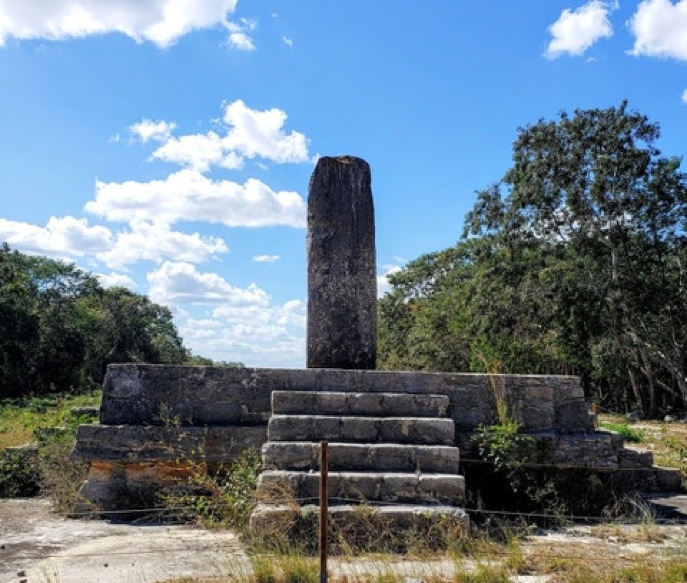
7. GNOMON, (STRUCTURE 12,) DZIBILCHALTUN This stela acts as gnomon, called In Yucatan, Lakuntun, a "big rock" or monolith and thought to be inhabited by K'awil or God K, the "manikin scepter" god who could turn a stela into a divination mirror where supernatural beings and ancestors could communicate with the king, especially on Koz Zumic Kin, the two zenithal days each year at cities in the tropics when the sun at noon is directly overhead, (May 27 and July 18 at Dzibilchaltun) and the gnomon casts no shadows. On the winter solstice the sun strikes this gnomon at a 45 degrees and so the length of its shadow and height are exactly the same. The ability to predict such events was central to the power of the priests and Mayan god kings. DZIBILCHALTUN'S COSMOLOGICAL SIGNIFICANCE Dzibilchaltun in Yucatecan means "the place with writing on flat stones," a reference to stelae and gnomons such as this. This name, however appropriate, was given it by the Spanish in the late 17th Century. The city's actual name was Ichkantiho, "the sky at five," most likely was a reference to Na-Ho-Kan, "The House at Five," the location in the Mayan creation myth where at the Maize god's command the Paddler Gods placed the Jaguar Stone Throne, the first of three making up the Cosmic Hearth, believe to be the three stars in the belt of the constellation Orion. The Maya distinguished six dimensions, the four cardinal plus the zenith and the nadir. The "sky unbilicus," represented by entwined snakes, (analogous to "vision serpents,") linked Mayan royalty to the gods in the heaven and their ancestors in the Underworld. This snake is sometimes shown as wound around the branches of Wakah-Kan, the "World Tree," the "Sky at Six," or "Raised up Sky" the Mayan name for the Milky Way, rising to the zenith or sixth dimension. Five may accordingly refer to the navel of the world, the crack in the cosmic turtle's made by Chac at the time of the Maize god's resurrection from Xibalba. It was regarded as, the "ol" or portal to the Underworld, Sak-Bak-Nakan, or "White Bone Snake," located at the foot of the Milky Way and World Tree. This association with the place of creation may have led the Itza in K'atun 11 Ahwa (771-791; 9.18.0.0.0.11 Long Count) to create their alliance for ruling the northern Yucatan at Ichkantiho, the counterpart in the present of Na Ho Kan, These two creations are juxtaposed and equated at the Lower Temple of Jaguar at Chichen Itza's ball court, thus legitimizing at the moment of creation, the Itza's eventual rule over the Maya.